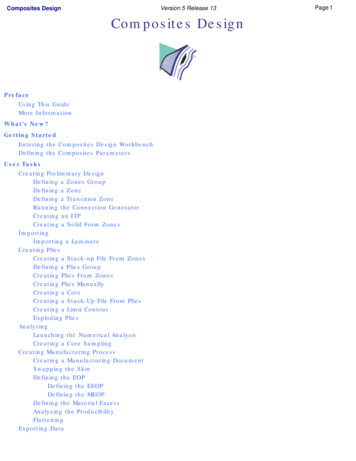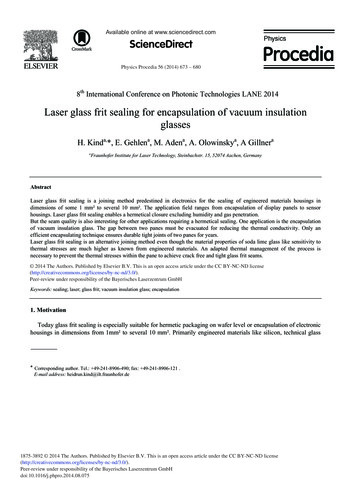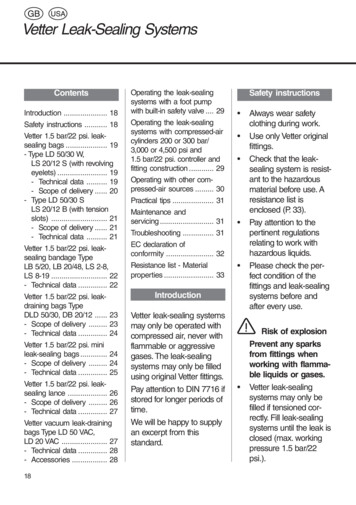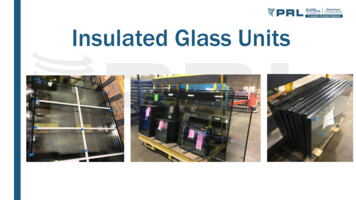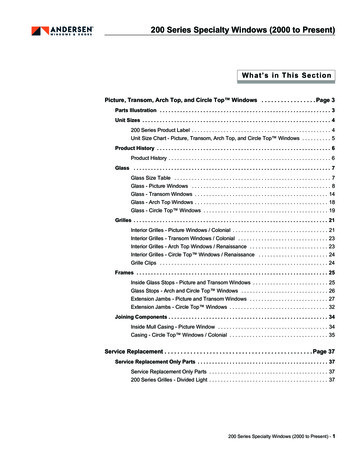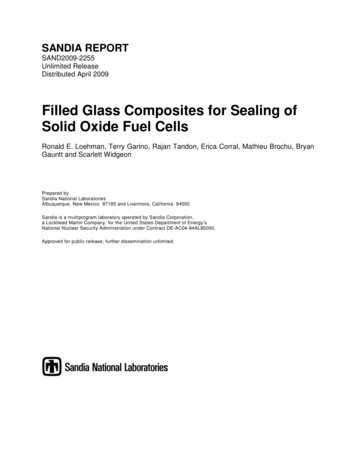
Transcription
SANDIA REPORTSAND2009-2255Unlimited ReleaseDistributed April 2009Filled Glass Composites for Sealing ofSolid Oxide Fuel CellsRonald E. Loehman, Terry Garino, Rajan Tandon, Erica Corral, Mathieu Brochu, BryanGauntt and Scarlett WidgeonPrepared bySandia National LaboratoriesAlbuquerque, New Mexico 87185 and Livermore, California 94550Sandia is a multiprogram laboratory operated by Sandia Corporation,a Lockheed Martin Company, for the United States Department of Energy’sNational Nuclear Security Administration under Contract DE-AC04-94AL85000.Approved for public release; further dissemination unlimited.
Issued by Sandia National Laboratories, operated for the United States Department of Energyby Sandia Corporation.NOTICE: This report was prepared as an account of work sponsored by an agency of theUnited States Government. Neither the United States Government, nor any agency thereof,nor any of their employees, nor any of their contractors, subcontractors, or their employees,make any warranty, express or implied, or assume any legal liability or responsibility for theaccuracy, completeness, or usefulness of any information, apparatus, product, or processdisclosed, or represent that its use would not infringe privately owned rights. Reference hereinto any specific commercial product, process, or service by trade name, trademark,manufacturer, or otherwise, does not necessarily constitute or imply its endorsement,recommendation, or favoring by the United States Government, any agency thereof, or any oftheir contractors or subcontractors. The views and opinions expressed herein do notnecessarily state or reflect those of the United States Government, any agency thereof, or anyof their contractors.Printed in the United States of America. This report has been reproduced directly from the bestavailable copy.Available to DOE and DOE contractors fromU.S. Department of EnergyOffice of Scientific and Technical InformationP.O. Box 62Oak Ridge, TN 37831Telephone:Facsimile:E-Mail:Online ordering:(865) 576-8401(865) /bridgeAvailable to the public fromU.S. Department of CommerceNational Technical Information Service5285 Port Royal Rd.Springfield, VA 22161Telephone:Facsimile:E-Mail:Online order:(800) 553-6847(703) v/help/ordermethods.asp?loc 7-4-0#online
SAND2009-2255Unlimited ReleaseDistributed April 2009Filled Glass Composites for Sealing of SolidOxide Fuel CellsRonald E. Loehman, Terry Garino, Rajan Tandon, Erica Corral, Mathieu Brochu,Bryan Gauntt and Scarlett Widgeon,Ceramic Processing and Inorganic Materials Dept.Electronic and Nanostructured Materials Dept.Materials Reliability Dept.Sandia National LaboratoriesP.O. Box 5800Albuquerque, NM 87185AbstractGlasses filled with ceramic or metallic powders have been developed for use as seals for solidoxide fuel cells (SOFC’s) as part of the U.S. Department of Energy’s Solid State EnergyConversion Alliance (SECA) Program. The composites of glass (alkaline earth-alumina-borate)and powders ( 20 vol% of yttria-stabilized zirconia or silver) were shown to form seals withSOFC materials at or below 900 C. The type and amount of powder were adjusted to optimizethermal expansion to match the SOFC materials and viscosity. Wetting studies indicated goodwetting was achieved on the micro-scale and reaction studies indicated that the degree ofreaction between the filled glasses and SOFC materials, including spinel-coated 441 stainlesssteel, at 750 C is acceptable. A test rig was developed for measuring strengths of seals cycledbetween room temperature and typical SOFC operating temperatures. Our measurementsshowed that many of the 410 SS to 410 SS seals, made using silver-filled glass composites, werehermetic at 0.2 MPa (2 atm.) of pressure and that seals that leaked could be resealed by brieflyheating them to 900 C. Seal strength measurements at elevated temperature (up to 950 C),measured using a second apparatus that we developed, indicated that seals maintained 0.02 MPa(0.2 atm.) overpressures for 30 min at 750 C with no leakage. Finally, the volatility of the boratecomponent of sealing glasses under SOFC operational conditions was studied using weight lossmeasurements and found by extrapolation to be less than 5% for the projected SOFC lifetime.3
DISCLAIMER“This report was prepared as an account of work sponsored by an agency of the United StatesGovernment. Neither the United States Government nor any agency thereof, nor any of theiremployees, makes any warranty, express or implied, or assumes any legal liability orresponsibility for the accuracy, completeness, or usefulness of any information, apparatus,product, or process disclosed, or represents that its use would not infringe privately owned rights.Reference herein to any specific commercial product, process, or service by trade name,trademark, manufacturer, or otherwise does not necessarily constitute or imply its endorsement,recommendation, or favoring by the United States Government or any agency thereof. The viewsand opinions of authors expressed herein do not necessarily state or reflect those of the UnitedStates Government or any agency thereof.”4
TABLE OF CONTENTSTitle Page .3Abstract .3Disclaimer .4Executive Summary.6IINTRODUCTION .7IIRESULTS AND DISCUSSION .10II-1II-2II-3II-4II-5II-6Initial Screening Studies .10Viscosity Measurements on Composites .13Wetting Studies on Composites .18Reactivity Studies .20Seal Strength Tests at Room and Elevated Temperatures .22Long-term Stability Studies .27IIISUMMARY.32IVFUTURE WORK.33VREFERENCES .34APPENDIX.355
EXECUTIVE SUMMARYThis report summarizes the development of glasses filled with ceramic or metallic particles forhermetic seals for solid oxide fuel cells (SOFCs) that was performed at Sandia NationalLaboratories as part of the Department of Energy’s Solid State Energy Conversion AllianceProgram. The composite approach to solving this most challenging sealing problem has theadvantage of flexibility in designing and controlling seal properties through the choice of fillercomposition, amount and particle size. We have demonstrated the feasibility of this approachusing alkaline earth alumina-borate glasses with silver or yttria-stabilized zirconia fillers presentat 20 vol%. Properties such as coefficient of thermal expansion (CTE), glass transitiontemperature (Tg) and viscosity were measured and this data allowed us to choose the mostsuitable glasses and fillers to, for example, match the CTE of SOFC materials. The preferredcompositions flow and bond to other SOFC components at temperatures generally below 900 Cand wetting experiments indicated excellent wetting on the micro-scale. The interfacialinteractions between the glasses and candidate interconnect stainless steels including spinelcoated 441 stainless steel showed that at 750 C, the extent of reaction was acceptably low. Thestrengths of seals were characterized both at room temperature and at SOFC use temperaturesusing gas overpressure techniques. The seals in general had adequate strength and, moreover,those that leaked could be resealed by reheating to the sealing temperature. Finally,volatilization of components, particularly B2O3, from glass surfaces was monitored by weightloss experiments and shown to be of minimal concern over the estimated SOFC lifetime. Inconclusion, we have demonstrated that powder-filled glass composites provide a promising andflexible solution to the challenging problem of sealing planar SOFCs.6
I.INTRODUCTIONSolid Oxide Fuel Cells (SOFCs) are multi-material structures formed primarily from high-puritymetal oxide components that generate electricity directly from the electrochemical oxidation of afuel. Since electricity is generated directly from the fuel, higher efficiency can be achievedcompared to standard generating methods where the fuel is combusted. Because of their highefficiency and low emissions of pollutants, SOFCs have been identified as important alternativeenergy sources.[1,2] SOFCs also have several advantages over other types of fuel cells. Due totheir relatively higher operating temperature, SOFCs do not need the expensive catalystsrequired by most types of low temperature fuel cells. Also because of the high temperatures,fuels can be internally reformed within the anode unlike low temperature fuel cells where, forexample, catalyst poisoning by carbon monoxide will occur. This allows SOFCs to operate on awide variety of fuels such as methane, propane, butane, natural gas, fermentation gas, gasifiedbiomass and even paint fumes. Much of the early work on SOFCs was based on a tubulargeometry, whereas recent interest has been on planar SOFC designs because they require simplermanufacturing processes, have relatively short current paths and produce higher power densitiesand efficiencies than tubular designs.[2,3]Planar SOFCs consist of a sandwich-like structure of an ionic oxygen-conducting electrolytelayer (typically yttria-stabilized zirconia, YSZ), an anode (typically nickel mixed with YSZ) thatis exposed to the gaseous fuel, a cathode (typically lanthanum strontium magnetite, LSM) that isexposed to air, and an interconnect material. The interconnect layer sits between each individualcell made up of an anode, electrolyte and cathode, connecting them in series so that theelectricity each cell generates can be combined. Since planar SOFC’s can operate at relativelylow temperatures (600-800 C) compared to tubular designs, low cost ferritic stainless steel-basedalloys are the interconnect materials of choice.In order to ensure efficient operation of a planar SOFC, a suitable sealant is required to preventthe fuel gas and air from mixing. Developing reliable methods for sealing solid oxide fuel cellstacks presents one of the most challenging set of performance requirements in the field ofceramic joining. For SOFC applications, the requirements on the sealing method for lifetimes upto 40,000 hr include [4]: adhesion of the sealing material to fuel cell components between room temperature andtemperatures as high as 1000 C ability to provide a leak-tight seal at the SOFC operating temperature ability to maintain a seal while accommodating strains from SOFC components withdifferent coefficients of thermal expansion (CTEs) no adverse reaction between the sealing material(s) and the fuel cell components attemperatures up to 1000 C chemical and physical stability of the sealant at temperatures up to 1000 C in oxidizingand reducing atmospheres thermal shock tolerance electrically insulating for some SOFC designs7
Note also that the requirements may be contradictory. For example, being leak-tight andadherent at high temperatures suggests a refractory, stiff sealant, which may work against therequirement for thermal strain accommodation. Such situations are common, and sealdevelopers know that seal design is specific to a particular component geometry and requirescompromises among competing requirements. In many ways, the seal performance will controlthe structural integrity and mechanical stability of the SOFC stack, and could also determine theoverall stack performance.[2]Accommodation of thermal expansion mismatch stresses will require SOFC seals to incorporateeither a ductile metal or a high-viscosity glass that can relieve stresses through viscous creep. Ofthese, oxide glasses have been the most investigated. There have been many reports on thedevelopment of a variety of compositional systems to form suitable glass and glass-ceramicsseals for SOFCs, including silicates, aluminosilicates, borosilicates, and aluminophosphates; i.e.,see references [5-7] and references therein. Many of these sealing glasses have property orperformance shortcomings, such as failure to remain thermomechanically stable under SOFCoperational conditions, or the occurrence of deleterious interfacial reactions with other SOFCcomponents. Moreover, the glass-only approach depends on finding a glass that has a highviscosity at the SOFC operating temperature and a weak viscosity-temperature function. Inglass technology parlance, those are “long” glasses. Since stresses develop as the glass is cooledbelow its set point, one desires as low a set point as possible; however, glasses with low setpoints generally will be too fluid at SOFC operating temperatures to maintain a seal.Another approach that has been investigated utilizes glass-ceramics, materials that are processedinitially as glass and then crystallized by appropriate heat treatment. This approach also suffersfrom some disadvantages. With glass-ceramics one is limited to the compositions and crystalmorphologies allowed by the thermodynamic phase equilibrium relations. Also, generally inglass-ceramics it is difficult to control the microstructure or the eventual phase assemblage. Toavoid these shortcomings of glasses and glass-ceramics and to provide maximum flexibility incontrolling CTE and viscosity, we have investigated a powder-filled glass composite approach.The powder-filled glass composite method developed at Sandia National Laboratories hassimilar objectives to the glass and glass-ceramic approaches being pursued by other groups, buthas the major advantage of far more flexibility in designing and controlling seal properties. Thisis because the composition of the glass and the filler are chosen independently and becausefurther control of properties can be achieved by optimizing the amount of the filler, and byadjusting its particle size distribution. One is still constrained by the system thermodynamics,but wider ranges of compositions and microstructures are possible than with single glasses orwith glass-ceramics.[8,9]In the work described here, we have demonstrated control of properties such as glass transitiontemperature and thermal expansion coefficient, by varying the compositions, amounts, andmicrostructures of the different phases. The choices were guided by thermochemical andcomposite microstructural models that allowed us to target specific seal properties for a givendesign.8
This report summarizes a multi-year research and development project on SOFC seals performedat Sandia with funding from the DOE/SECA program. The salient accomplishments include:Synthesis of candidate glasses and measurement of their properties such as Tg and CTE.Fabrication of both ceramic and metal powder-filled glass seals.Characterization of viscosity and wetting behavior of composite sealing materials.Studies of the reactivity of seal glasses with SOFC materials.Determination of the strength of glass composite seals at room temperature and at theservice temperature. Determination of the long-term stability of the glasses with respect to weight loss. Collaboration with other SECA program researchers on properties measurements,specimen exchange, and design information. 9
IIRESULTS AND DISCUSSIONII-1Initial Screening StudiesOver 30 different glass compositions in the Mg-Ca-Ba-La-Al-Si-B-O family, with potential forthe filled glass composite seal approach, were made and their glass transition temperatures (Tg,by Differential Thermal Analysis) and coefficients of thermal expansion (CTE, by dilatometry)were measured. The original group of compositions did not contain any silicon because ofconcern at that time that reaction with silicates would lower the ionic conductivity of the YSZelectrolyte. Later in the program silicon was considered not to be as detrimental as believedearlier, so we included some borosilicate glasses in our matrix of compositions. Figure 1 showssome of the initial thirty glasses on a plot of Tg as a function of CTE. The plot shows that thegeneral correlation of high Tg with low CTE does not hold and that these glasses have a widerange of property combinations. The closer the glass CTEs are to the values for the YSZelectrolyte, 10.5 x 10-6/ C, the lower the mismatch stresses will be. Although most glasses hadCTE values well below that of YSZ, several had values that were close and these had Tg valuesthat ranged from 550 to 750 C. Glasses with Tgs between about 550 and 625 C seemed to bestfit the flow constraints.850Reported hereBrowOther800YSZ750Tg70065060055056789CTE (x 10-6/ C)1011Figure 1. Glass compositions plotted as a function of Tg and CTE. Blue diamonds were glasses selected for furtherdevelopment, red squares were glasses provided by Prof. R. Brow, Missouri University of Science & Technology,and the green triangles were other glasses not studied further.To verify the viability of making filled glass composite seals, a number of ceramic and metalpowders, including, YSZ, Al2O3, Ni, Cr, and Ag, were added to the candidate glasses and thenthese were sealed to various SOFC materials. For example, Figure 2 shows two micrographs ofa seal to YSZ that comprises a composite layer with 70 vol% YSZ powder and 30 vol% of one ofour earlier sealing glasses bonded with a thin layer of the same glass. The composite CTE hasbeen adjusted to 10.2 x 10–6/ C. The seal adheres tightly to the YSZ and survived multiple10
thermal cycles up to 850 C. Later work showed that the presence of the pure glass layer was notneeded as the composites formed good seals without the pure glass layer, as shown below.Based on initial tests of this kind, we selected several promising candidate glasses for furtherinvestigation. These high-B2O3 glasses (see Table 1) have Tg’s from 569 to 595 C and CTE’sfrom 7 to 10 x 10-6/ C. Composites made with these glasses and ceramic or metal powders canmatch the CTE of YSZ. Metal powders such as silver (CTE 19 x 10-6/ C) are more effectivethan ceramics at increasing the CTE of the glasses.Composite interlayerGlass sealing layerYSZComposite interlayer:70vol% YSZ – 30vol% GlassNote: no pressure applied Ceramic: 70 vol% YSZ Glass: Tg 703oC , CTE 9.7x10-6/oC Composite CTE 10.2x10-6/oC (200-700oC)Figure 2. Glass - ceramic seal bonded to YSZ substrate with thin layer of the same glass as in the composite. Thisearly design was later replaced by the simpler all composite seal.Table 1. Compositions and properties of glasses selected as the best candidates for SOFC sealing. (Note thatcomposition is in mol%, Tg is in C and CTE is 1/ C x 106.)Glass ID 205759.4396010300056910Glass composite seals incorporating a ductile metal accommodate the CTE mismatch stressesthrough deformation of the metal. Figure 3 is an example with 20 vol% Ag and 80 vol% of glass#14a. This composition is electrically conductive because the Ag is just above the percolationlimit. We can obtain an insulating seal with similar mechanical properties by reducing slightlythe amount of Ag. These initial studies proved that the concept of using powder-filled glasscomposites to seal SOFCs warranted further investigation.11
SeallayerMountCompositecore2mmYSZ Glass: Tg 575 oC , CTE 9.4X10-6 / o C Filler metal: 20 vol% Ag Composite: Tg 566 oC, CTE 10.5X10 -6/ oC Resistance: 0.1 ohmCrystalsMetallicphaseGlassFigure 3. Micrographs of glass-Ag composite showing that an electrically conductive seal can be obtained byadjusting the amount of the Ag.Availability of manufacturable processes is always an issue in materials joining. Figure 4illustrates that ceramic-filled glass composite seal materials can be formed by tape casting, atechnique common to microelectronic packaging multi-layer capacitor manufacturing. Thegreen (unfired) tape, with a solids loading of 65%, can be cut to the shape required for the bondarea and stacked so that the whole assembly is sealed and otherwise processed in a co-fireoperation.Type of cast Additive / vol%Vol% SolidPure glassN/A65%Glass-ceramiccompositeYSZ / 30vol%65%Glass-metalcompositeNi / 30vol%65%Typical volume% solidof common tape castis 65%Tape cast thicknesses0.56 to 0.85mm (green)Figure 4. Glass-powder composites can be prepared as green tapes similar to those used in microelectronicpackaging. This approach allows more processing options.12
II-2. Viscosity Measurements on CompositesOnce the viability of using filled glass composites was established, we began furtherinvestigation and characterization of these materials. The first parameter we investigated wasviscosity. Data on the variation of viscosity as a function of composition, relative volumefraction of glass and filler, and temperature allowed us to assess the performance of differentcomposites and to choose the best combinations of materials for the expected operatingconditions. Viscosity controls the flow of seal materials at temperature. If the viscosity is toohigh the sealant will not flow enough to make the seal and it also will not be able to dissipatethermal expansion mismatch stresses. If the viscosity is too low, the sealant will not stay in thejoint and the seal may leak and be too weak. In typical glass seal development efforts, the flowand sealing properties are determined by laborious trial and error experiments with little or noquantitative data. We used an apparatus, described below, that allowed us to observe and videorecord glass flow and wetting on different substrates as a function of temperature and then tomeasure the glass viscosity under those same conditions. These measurements allowed muchmore rapid determination of optimum processing conditions and correlated those results withquantitative viscosity data.Measurements of composite viscosities were made using the parallel plate method in ourTOMMI apparatus (Thermo Optical Mechanical Measuring Instrument, Fraunhofer Gesellschaft,Wurtsburg, Germany, see Figure 5), a high temperature optical dimension measuring apparatusthat allows in situ video recording of specimens up to a temperature of 1700oC. A parallel plateviscometer setup (Figure 6) was used to measure viscosity of the candidate glasses and todetermine the effect of additive powder composition, size, and aspect ratio on composite sealflow and adhesion. The viscosity, η, is determined from the measured rate of sample thicknesschange, dh/dt, at a given applied load, M, using the following equation:2 Mgh 5h 30V (D h/D tp)( 2ph 3 V )(1 a D T)Eq. 1where g gravity acceleration, h sample height, V sample volume, a CTE of the sample,and DT temperature change compared to room temperature.Figure 5. A photo of the Thermo Optical Mechanical Measuring Instrument (TOMMI) that was used to measureviscosity of glasses and composites at elevated temperatures.13
Mha.b.Figure 6. (a) A schematic of the parallel plate geometry used to measure viscosity in the TOMMI and (b) an imagefrom the TOMMI showing initial sample arrangement.The viscosities of the base candidate glasses as a function of temperature are shown in Figure 7.Glass #10, which had the highest Al2O3 content, also had the highest viscosity, 10x that of theother glasses, whereas the glass with the most B2O3, #39, had the lowest viscosity. Between680 and 760 C, the viscosity decreased by about 2 orders of magnitude. For example, for glass#10 the viscosity decreased from 10 to 0.1 MPa s over this temperature range.12Pure 10Pure 39Pure 14aViscosity (MPa s)1086420680700720740Temperature ( C)Figure 7. The measured viscosity of the three candidate glasses without any additives.14760
Composite viscosity increased with increasing volume fraction of either metal or ceramicparticles. This well-known effect was modeled using the Euler equation, where ηr is thenormalized viscosity, Φ is the volume fraction of the particle phase and k and Φc are constantsfor a given filler particle size distribution: kf h r 1 (1 - f / fc ) 2Eq. 2Additionally, the particles increase the available surface area for wetting by the glass andtherefore keep the glass contained in the composite seal material. The effect of additions ofvarious volume fractions of YSZ powder (particle size 25 to 37 µm) on the viscosity of glass#14a as a function of temperature is shown in Figure 8. Figure 9 indicates that the data in Figure8 can be accurately fit by Eq. 2 thus allowing prediction of viscosity at other loading levels.Figure 10 shows that the viscosity behavior is very similar, as expected, when the additive toglass #14a is zirconia or silver. Even though the data appear to converge at higher temperatureson this linear plot, the powder-filled glasses maintain higher viscosity even at higher temperatureas is illustrated in Figure 11. This figure shows that after 10 min at 850 C, an initiallyrectangular sample of glass #14a forms a sessile drop shape, whereas the same glass loaded with30% YSZ maintains its original shape, indicating that it has a much higher viscosity. As thesedata indicate, a wide range of temperature-viscosity behavior can be attained using the glasscomposite approach, and the design limitations imposed by a pure glass seal approach can beovercome with the selective addition of a solid particle phase.120Pure glass 14a14a 05 vol% ZrO214a 10 vol% ZrO214a 20 vol% ZrO214a 30 vol% ZrO214a 40 vol% ZrO2Viscosity (MPa s)100806040200650660670680690700710720Temperature ( C)Figure 8. The measured viscosity of zirconia/glass #14a composites as a function of temperature at various loadinglevels.15
Figure 9. The viscosity data for zirconia/glass #14a composites fit to the Euler equation for temperatures of 650 ,675 and 700 C.2514a 20 vol% Ag14a 5 vol% AgPure glass 14a14a 5 vol% ZrO214a 20 vol% ZrO2Viscosity (MPa s)20151050660680700720740760Temperature ( C)Figure 10. Measured viscosity of composites of glass #14a and either zirconia or silver showing that amount ofadditive is much more important than the additive composition.0%10 %30 %EbriteFigure 11. Glass #14a - YSZ powder mixtures (0, 10 and 30% YSZ) heated on Ebrite stainless steel for 10 min at850 C. The red rectangles indicate the original sample size.16
Two other aspects of the increase in viscosity of glass upon addition of ceramic and metalpowders are important for composite performance. First, as shown in Figure 12, the particle sizeof the filler phase has a significant effect on the viscosity. In this case, the expected increase inviscosity was only seen for relatively small (4 to 7 µm) silver particles. The second issue is theeffect of the filler on the crystallization behavior of the glass. The addition of ceramic particlescan alter the glass crystallization behavior by providing nuclei for crystallization. As more of theglass crystallizes, the composite viscosity will rapidly increase. The crystallization kinetics ofthe pure glass and the metal and ceramic composites were studied using differential thermalanalysis. It was found that the ceramic particles had a much greater effect on the crystallizationof the glass than the metal additives, resulting in a higher volume fraction of particles in theglassy seal and a corresponding increase in the seal viscosity beginning at the onset of thecrystallization. This increased viscosity can improve seal performance by increasing its strength.14a with 38-44 mm Ag particles14a with 4-7 mm particles of Ag3 1073 10772.5 1014a-5 vol% Ag14a-10 vol% Ag14a-15 vol% Ag14a-20 vol% Ag72.5 10T 576 CgViscosity, MPa sViscosity, Pa sT 576 C2 10714a-5 vol% Ag14a-10 vol% Ag14a-20 vol% Ag1.5 1071 1075 106g2 1071.5 1071 1075 1060620 630 640 650 660 670 680 690 7000620 630 640 650 660 670 680 690 700Temperature, CTemperature, CFigure 12. The effect of addition of silver powder on the viscosity of glass #14a for two different sizes of silverparticles.17
II-3. Wetting Studies on CompositesWe also measured spreading rates and contact angles of composite sealants on different SOFCmaterials at temperature in the TOMMI instrument. These properties depend on both viscositiesand surface energies of the seal constituents. A low contact angle indicates good wetting.Contact angles and spreading rates are needed to specify heating schedules for seal formationand to determine adhesion and compatibility of the seal materials with different substrates. Forexample, Figure 13a shows that glass #10, the higher alumina, higher viscosity glass, does notwet (high contact angle) a polycrystalline alumina substrate even when heated to 900 C, whereasthe other two glasses start to wet between 750 and 850 C. Figure 13b shows that for glass #14a,the wetting behavior is little changed when up to 10 vol% zirconia is added, but that at 20 vol%,wetting does not occur even at 900 C. (The wetting experiments were carried out
Glasses filled with ceramic or metallic powders have been developed for use as seals for solid oxide fuel cells (SOFC's) as part of the U.S. Department of Energy's Solid State Energy . Many of these sealing glasses have property or performance shortcomings, such as failure to remain thermomechanically stable under SOFC operational .
